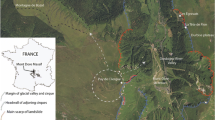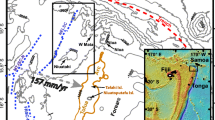Abstract
Samples collected from a lava channel active at Kīlauea Volcano during May 1997 are used to constrain rates of lava cooling and crystallization during early stages of flow. Lava erupted at near-liquidus temperatures (∼1150 °C) cooled and crystallized rapidly in upper parts of the channel. Glass geothermometry indicates cooling by 12–14 °C over the first 2 km of transport. At flow velocities of 1–2 m/s, this translates to cooling rates of 22–50 °C/h. Cooling rates this high can be explained by radiative cooling of a well-stirred flow, consistent with observations of non-steady flow in proximal regions of the channel. Crystallization of plagioclase and pyroxene microlites occurred in response to cooling, with crystallization rates of 20–50% per hour. Crystallization proceeded primarily by nucleation of new crystals, and nucleation rates of ∼104/cm3s are similar to those measured in the 1984 open channel flow from Mauna Loa Volcano. There is no evidence for the large nucleation delays commonly assumed for plagioclase crystallization in basaltic melts, possibly a reflection of enhanced nucleation due to stirring of the flow. The transition of the flow surface morphology from pāhoehoe to 'a'ā occurred at a distance of 1.9 km from the vent. At this point, the flow was thermally stratified, with an interior temperature of ∼1137 °C and crystallinity of ∼15%, and a flow surface temperature of ∼1100 °C and crystallinity of ∼45%. 'A'ā formation initiated along channel margins, where crust was continuously disrupted, and involved tearing and clotting of the flow surface. Both observations suggest that the transition involved crossing of a rheological threshold. We suggest this threshold to be the development of a lava yield strength sufficient to prevent viscous flow of lava at the channel margin. We use this concept to propose that 'a'ā formation in open channels requires both sufficiently high strain rates for continued disruption of surface crusts and sufficient groundmass crystallinity to generate a yield strength equivalent to the imposed stress. In Hawai'i, where lava is typically microlite poor on eruption, these combined requirements help to explain two common observations on 'a'ā formation: (a) 'a'ā flow fields are generated when effusion rates are high (thus promoting crustal disruption); and (b) under most eruption conditions, lava issues from the vent as pāhoehoe and changes to 'a'ā only after flowing some distance, thus permitting sufficient crystallization.
Similar content being viewed by others
Author information
Authors and Affiliations
Additional information
Received: 3 September 1998 / Accepted: 12 April 1999
Rights and permissions
About this article
Cite this article
Cashman, K., Thornber, C. & Kauahikaua, J. Cooling and crystallization of lava in open channels, and the transition of Pāhoehoe Lava to 'A'ā. Bull Volcanol 61, 306–323 (1999). https://doi.org/10.1007/s004450050299
Issue Date:
DOI: https://doi.org/10.1007/s004450050299




